When people think of North Carolina, a few things might come to mind. If you are an avid nature lover, you might think of the Great Smoky Mountains. If not, your mind might gravitate to the Carolina Panthers – a famous football team from the state. More of a foodie? You probably already know that Krispy Kreme originated in North Carolina back in 1937! Overall, this state is a true powerhouse when it comes to diversity. Having said that, let’s explore 15 of the most extraordinary natural attractions in North Carolina, including protected parks and other unique landmarks.
1. Great Smoky Mountains National Park
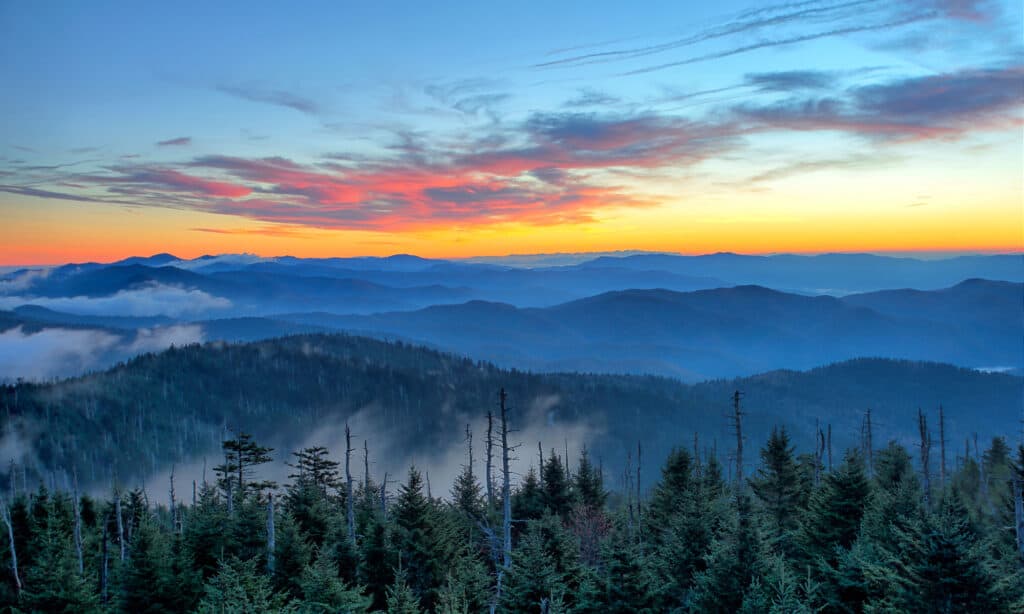
This national park gets its name from the ever-present morning fog that occurs there.
©Trent Carmichael/Shutterstock.com
Starting with probably the most famous of all the natural wonders in North Carolina is the Great Smoky Mountains National Park. It is the most visited national park in the United States and is one of the few that forgo an entrance fee. Located in the western part of the state, this iconic protected park is a hub for a variety of animal species such as American black bears, coyotes, white-tailed deer, bobcats, and many others. Home to 13 species of frogs and toads, as well as 30 different species of salamanders, this protected area earned its title of being the salamander capital of the world.
Spread out almost equally between North Carolina and Tennessee, it encompasses a whopping 522,427 acres of land. Over 130 species of trees are found in the vast expanse of wilderness there. Some of these include yellow birch, basswood, yellow buckeye, and tulip trees. This park also features over 850 miles of hiking trails, all of which offer visitors the chance to explore some of the most untouched wilderness in the country.
People come to the area to spot native wildlife or escape the hustle and bustle of city life and relax in nature! Plus, the Great Smoky Mountains contain some of the highest peaks in eastern North America. Clingman’s Dome and Mount Mitchell are two popular summits with areas reaching a maximum height of 6,643 and 6,684 feet, respectively. These areas offer fantastic views of the landscape as well as steep hiking trails.
Great Smoky Mountains in the Spring
Though the Smokies are a fan-favorite park year-round, each season offers something different for its visitors. In the spring, you can catch a glimpse of any one of the 1,500 native flowering plants that are in bloom during this season. Some of the most prevalent species to keep an eye out for are Trillium, Bleeding Heart, Flame Azalea, and Dutchman’s Britches.
Great Smoky Mountains in the Summer
Moreover, summer has the perfect weather to explore any of its diverse hiking or waterfall trails. For inspiration, Mount Leconte is the most popular hike, consisting of 11 miles of scenic trails and an elevation gain of 2,763 feet. Beware though, the summer season is also the busiest, so make sure to come early to beat the crowds and get the most out of your time in this park!
Great Smoky Mountains in the Fall
In spite of summer’s popularity, many believe the very best time to visit this national park is actually during fall, which is when the foliage is at its peak. This is typically between mid-October through early November. To fully enjoy the autumnal experience and maximize visibility, visitors can choose to drive the Clingmans Dome Road or the Foothills Parkway.
Great Smoky Mountains in the Winter
Alternatively, the Smokies transform into a winter wonderland from December to February. At this time, visitors of this famous national park can enjoy winter hikes, spot frozen waterfalls, or opt for snow tubing, skiing, or snowboarding. Since each season is so contrasting, you just have to come back to bear witness to all the natural wonders that can be found in the Smokies!
2. Blue Ridge Parkway
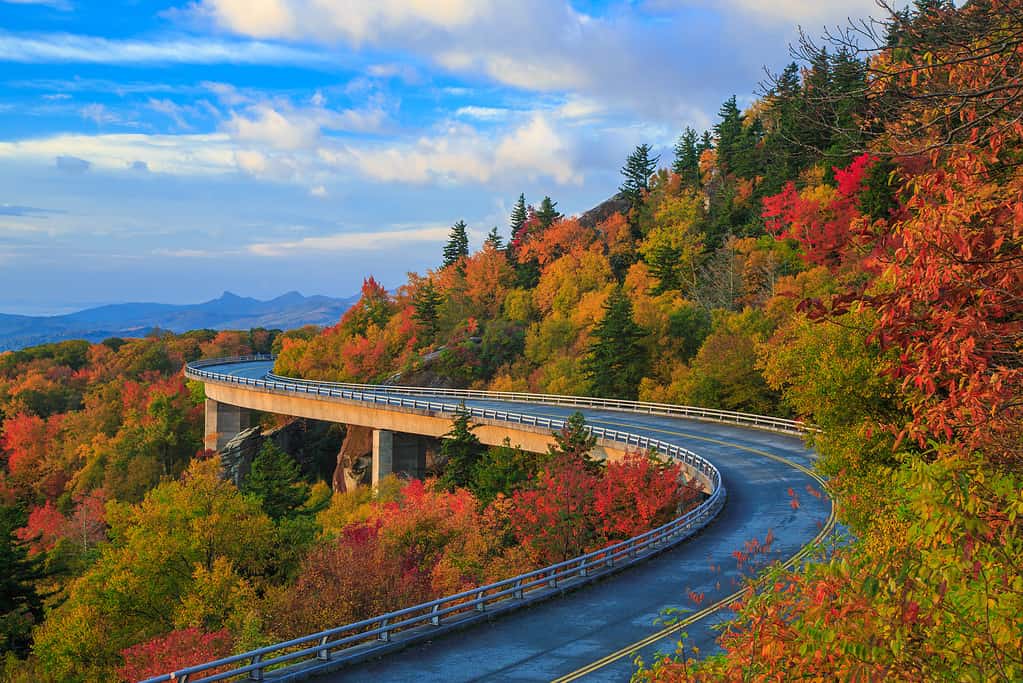
Connecting the Smoky Mountains to Shenandoah, this 460-mile parkway allows you to travel through two whole states without ever stopping at a stoplight or stop sign! (Though you definitely should stop at least once to fully enjoy its scenic views.)
©jaredkay/iStock / Getty Images Plus via Getty Images
Another must-see destination is the Blue Ridge Parkway, which spans across both North Carolina and Virginia. This road offers breathtaking views of the world-famous Blue Ridge Mountains. Around the area, visitors can find a slew of hiking trails fit for people of all experience levels. It also features an abundance of scenic overlooks and wildlife-spotting opportunities. This makes it a great stop for expert hikers, novice family vacationers, and everybody in between!
3. Outer Banks
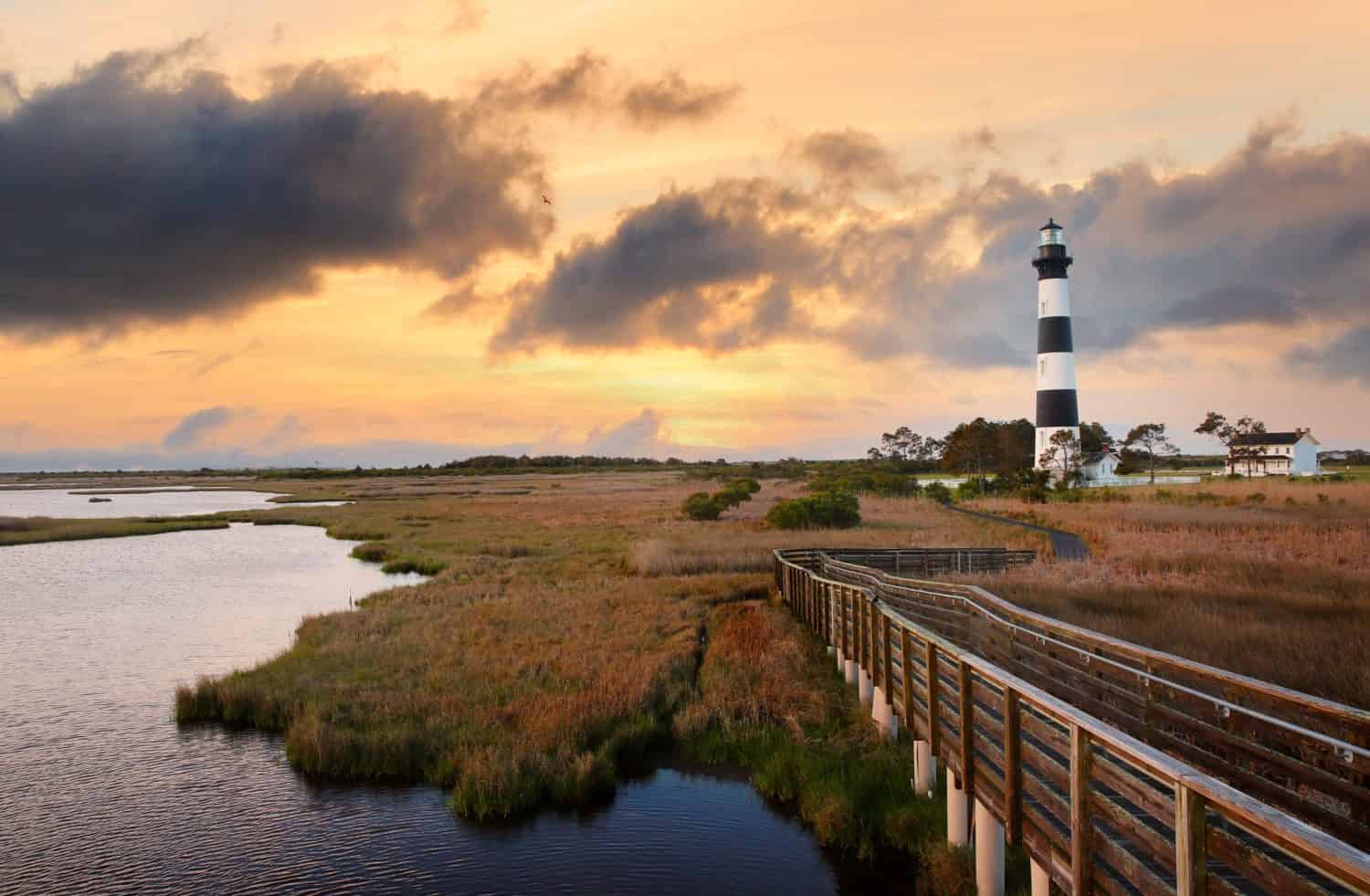
Roanoke Island makes up a distinctive portion of the Outer Banks, and its native people became known by the English for trading shells from their island.
©Jay Yuan/Shutterstock.com
The Outer Banks is the string of barrier islands along the coast of North Carolina, totaling a mere 200 miles in length. It separates the Atlantic Ocean from the mainland. Though it might not be as expansive as some other places on this list, it is still worth a visit (or two)! The Outer Banks is most famous for its stunning beaches, picturesque beachfront, and the Cape Hatteras National Seashore. Designated as the first national seashore in the United States, this protected area provides ideal habitats – and protection – for animals like green sea turtles and piping plovers.
The Outer Banks are also known for its historic lighthouses and towering sand dunes, some of which reach mind-blowing heights of 80 to upwards of 100 feet! Visitors to the area can enjoy activities ranging from swimming and fishing to historic tours by land, sea, or air! The summer months are especially ideal for beachgoers hoping to catch some rays or some waves.
4. Shackleford Banks
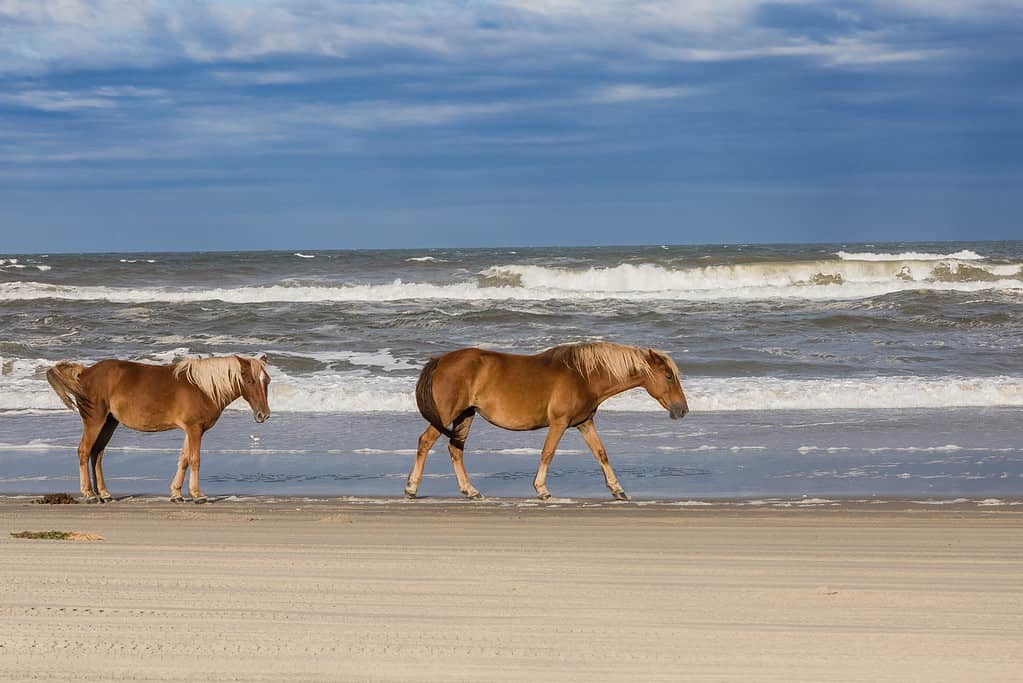
Looking for a more relaxed, low-effort vacation where you can just sprawl out and enjoy the beach? If so, Shackleford Banks might just be the perfect destination for you!
Marvel at the remote, wild beauty of Shackleford Banks and explore the variety of things to do across its grounds along the Cape Lookout National Seashore! These barrier islands are most famous for their wild Iberian (Spanish) horses, or Banker horses. According to experts, they were likely brought to the area in the 1500s on Spanish ships. When they were shipwrecked or left behind at failed settlements, the horses adapted to survive in their new environment.
Some ways in which these majestic creatures have acclimated to the Shackleford Banks include digging for springs or searching for fresh water in saltwater ponds and grazing on marsh or dune grasses. They also have adjusted to inclement weather and bad storms by seeking refuge in the maritime forest. Furthermore, there are between 110 and 130 native horses living in Shackleford Banks, and you can take a guided tour by boat or ferry to get an up-close and personal viewing experience with them.
Having said that, these horses are kept wild and are not fed, watered, or otherwise cared for. This means that they are unpredictable and should not be fed, touched, teased, or intentionally disturbed. Enjoy these wild horses from a safe distance (50 feet) and always be respectful of the grounds they call their home!
Non-Horse-Related Activities in Shackleford Banks
If horses are not of interest to you, Shackleford Banks also offers an abundance of shelling opportunities on both sides of the 9-mile island. Alternatively, visitors can go birding, fishing, hiking, hunting, kayaking, and canoeing in this area as well. If you do stop by, make sure to check out the famous Currituck Lighthouse, which was the final lighthouse built on the Outer Banks in 1873. At 162 feet, it still stands as one of the tallest beacons in the US. It features a 220-step staircase and has a unique, unpainted exterior so people can distinguish it from other lighthouses along the Outer Banks seashore.
5. Jockey’s Ridge State Park

Jockey’s Ridge State Park covers 426 acres with three unique ecosystems spread across it: the Roanoke Sound, the dune system, and the maritime forest.
©Jill Lang/Shutterstock.com
Another one of the extraordinary natural attractions in North Carolina is Jockey’s Ridge State Park. Situated in the Outer Banks, this scenic destination is home to the tallest living sand dune, which reaches up to 100 feet in height. Having said that, the sand dunes here are constantly changing, with their size and shape varying exponentially across each season. Visitors can hike to the top of the dunes, fly kites, or simply enjoy the stunning sunsets at the top of the dunes’ peaks. Hang-gliding is one of the most sought-after activities in Jockey’s Ridge. Due to its varied landscapes, kiteboarding, swimming, paddling, and sandboarding are other popular attractions as well. The park is accessible year-round, but arguably the best time to visit is for Independence Day. On this holiday, tourists can witness celebratory fireworks in Nags Head, Kill Devil Hills, and Manteo.
Interestingly enough, there is somewhat of a local tale around Jockey’s Ridge State Park. As the legend goes, Nags Head Hotel was a prolific lodge in the area. One day, it was entirely engulfed and swallowed up by the sand dune. While some debate whether the hotel ever actually existed, it was allegedly built in the early 1850s. For those who believe this local legend, it is said the hotel remains intact 100 feet below the sand to this very day.
6. Chimney Rock State Park
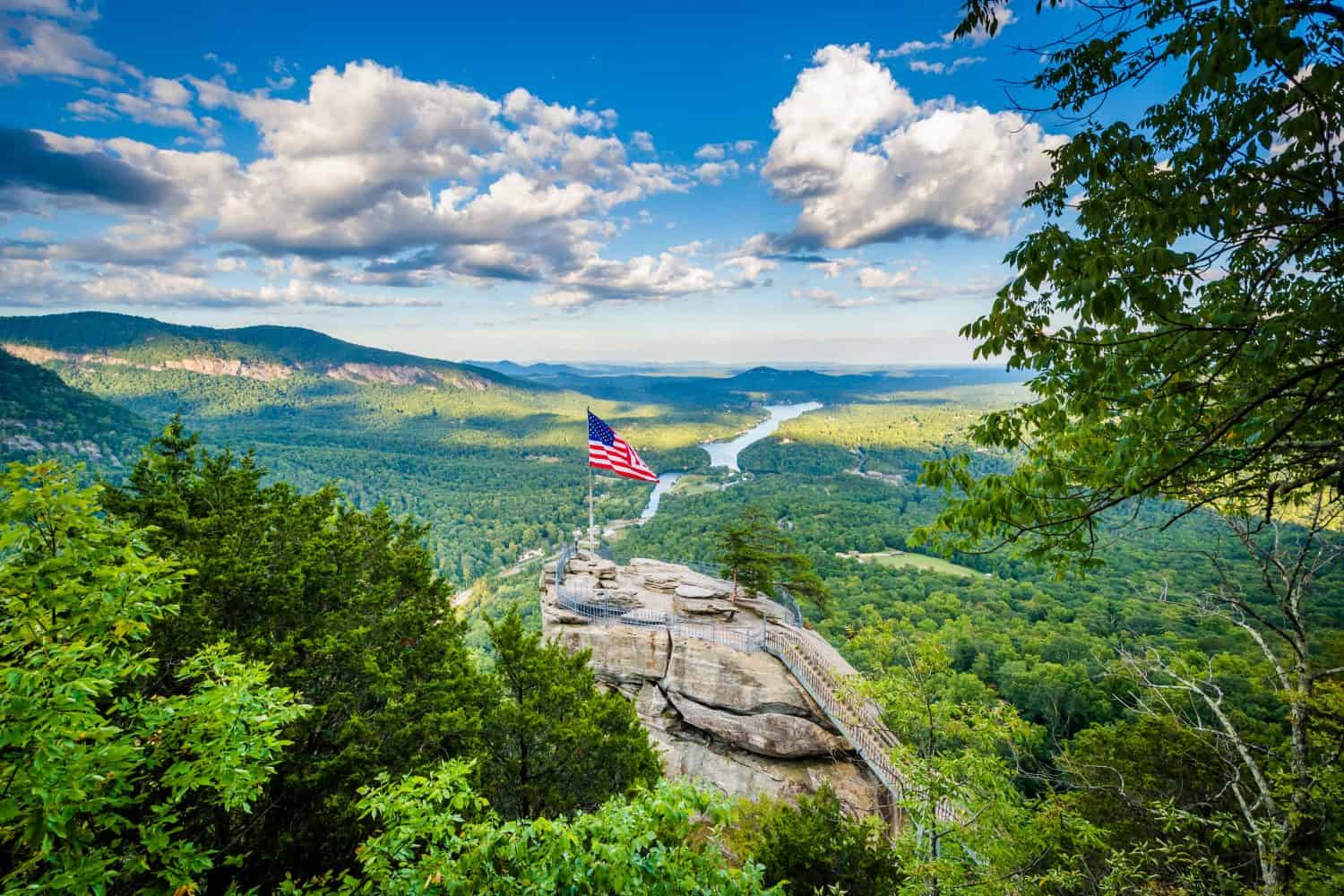
This state park features more than 20,000 feet of streams and waterfalls, as well as countless hiking trails.
©Jon Bilous/Shutterstock.com
Chimney Rock State Park, located near Lake Lure, is yet another extraordinary natural attraction in North Carolina. This site is perfect for naturalists as it offers sweeping views of towering granite monoliths and gorgeous landscapes like Hickory Nut Falls, one of the highest waterfalls in the Eastern United States. Interestingly enough, this was actually the site of the climactic fight scene in the famous film “The Last of the Mohicans”.
Besides that, Lake Lure provides fantastic boating, swimming, fishing, and hiking opportunities. Or, stop by the Lake Lure Flowering Bridge — home to more than 2000 species of native plants like Aster, Beautyberry, Black-eyed Susan, Chrysanthemums, and Irises. Chimney Rock Gemstone Mine also delivers a unique, hands-on experience for visitors of Chimney Rock State Park! For those planning a visit, spring and fall are some of the best times. This is due to the park’s comfortable temperatures, blooming flora, active fauna, and striking multi-colored leaves.
7. Mount Mitchell State Park
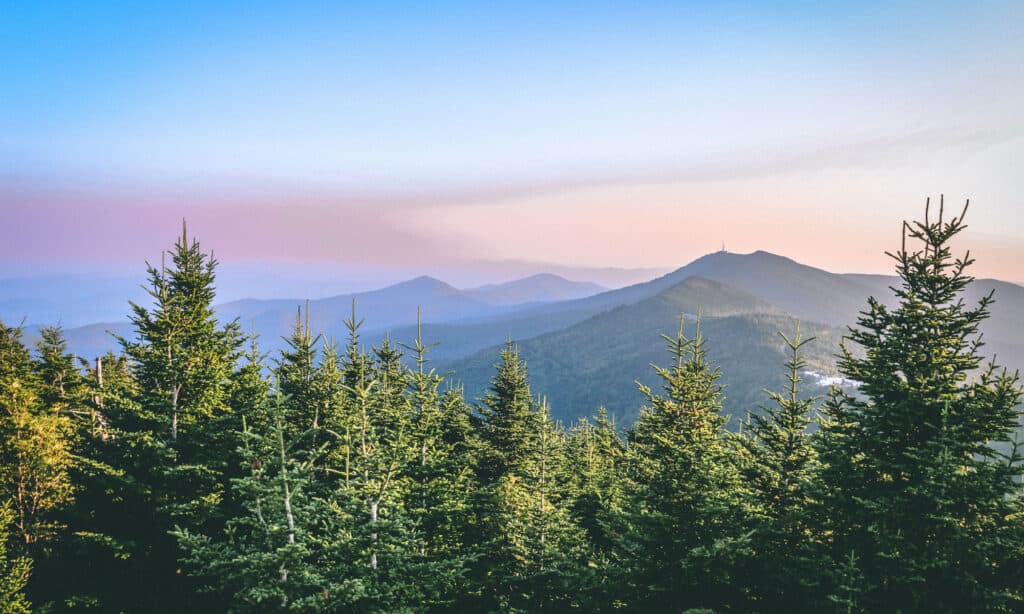
Attakulla Mountain was renamed after Elisha Mitchell, a UNC professor who surveyed it as the highest point in the eastern U.S. He died on the mountain in 1857 and was buried at its peak.
©iStock.com/Frederik Flagstad
Sitting at 6,684 feet above sea level, Mount Mitchell is home to the highest mountain peak in all of the Eastern United States. Backpackers, campers, and hikers flock to the summit for its unparalleled panoramic views. Throughout Mount Mitchell State Park, visitors can find a variety of hiking trails that explore the depths of the 4,789-acre forest.
One of the most famous is the Mount Mitchell Trail, which is an advanced hike from Black Mountain Campground on the Toe River to the very top of Mount Mitchell. The trail is 11.2 miles out-and-back with an elevation gain of just over 3600 feet. This daunting hike is not for beginners and takes an average of 7 hours and 7 minutes to complete in its entirety. If you decide to tackle the challenge of the Mount Mitchell Trail, make sure to bring plenty of water, dress appropriately, and be prepared with proper tools, gear, and emergency supplies. For those not looking to scale the mountain on foot, you can drive almost all the way to the top by taking the Blue Ridge Parkway north from Asheville and continuing up on North Carolina Highway 128.
8. Hanging Rock State Park
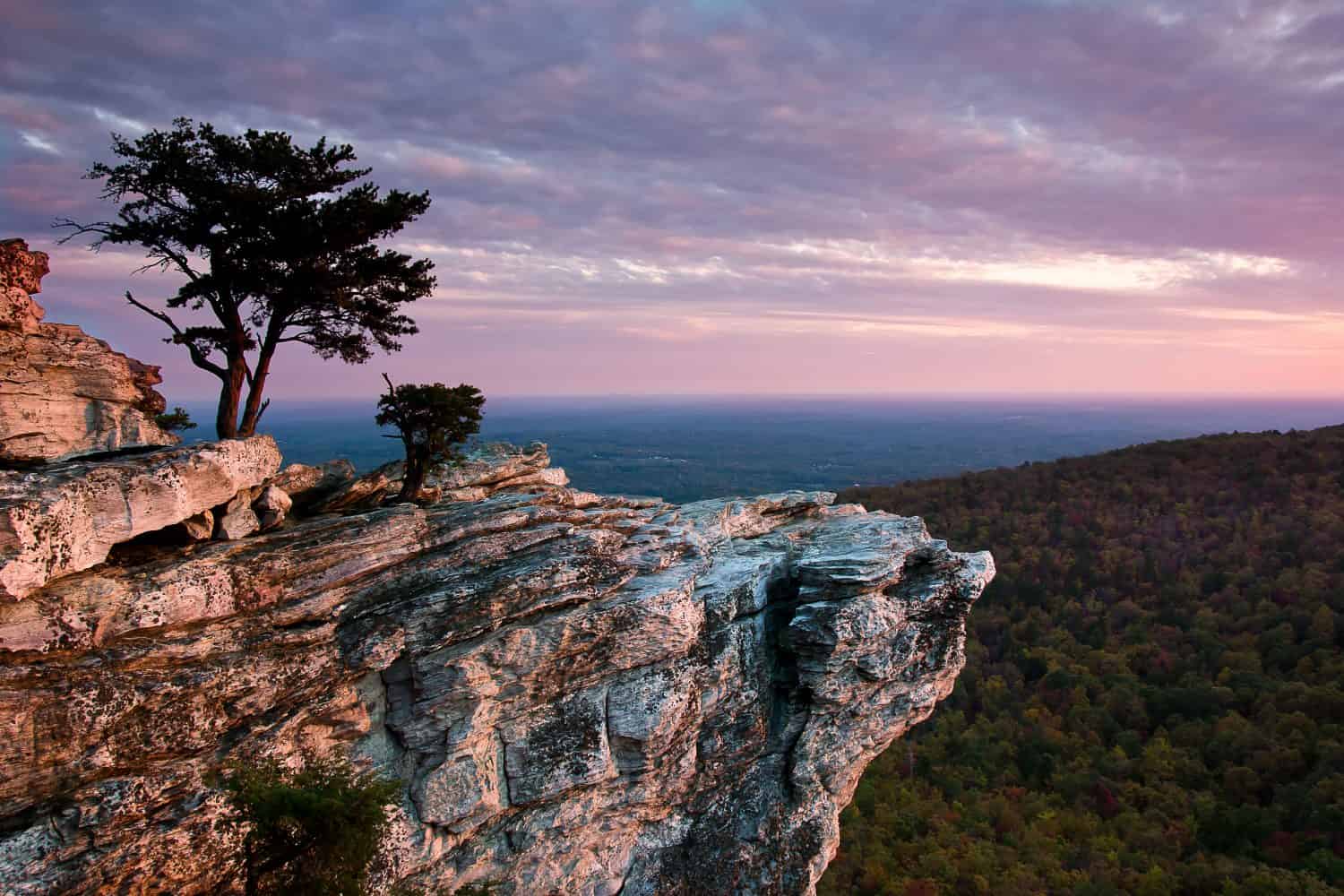
Hanging Rock State Park is one of the best natural wonders in North Carolina, offering stunning views of the Dan River Valley as well as the Blue Ridge Mountains.
©Greg Dollyhite/Shutterstock.com
Another extraordinary natural wonder of North Carolina is Hanging Rock State Park. Nestled in the Sauratown Mountains, this park is known for its expansive, unique rock formations and beautiful waterfalls. Hanging Rock State Park is an ideal destination for those who have limited time in the area. In a single day, visitors can explore all five of the park’s featured waterfalls in addition to hiking to the summit of Hanging Rock. Alternatively, visitors can enjoy any of the park’s other hiking trails, which are spread across 20 miles. Hanging Rock State Park also has a scenic lake for fishing, swimming, and boating, as well as excellent grounds for camping. Beyond that, horseback riding and mountain biking are two other popular outdoor activities for those visiting this state park.
9. Linville Gorge and Linville Falls

The Linville Gorge Caverns are a popular tourist destination, featuring guided walking tours year-round.
©Gestalt Imagery/Shutterstock.com
Two more natural wonders in North Carolina are Linville Gorge and Linville Falls. Located in the Pisgah National Forest, the Linville Gorge is often referred to by locals as the “Grand Canyon of the East.” This is due to its deep chasms and unique rock formations like Sitting Bear, Hawksbill, Table Rock, and the Chimneys. Many of this area’s trails lead to the spectacular Linville Falls, which is likely the most famous waterfall in all of Blue Ridge. Once there, visitors can enjoy its cascading waterfalls and panoramic views of the surrounding forest.
10. Grandfather Mountain
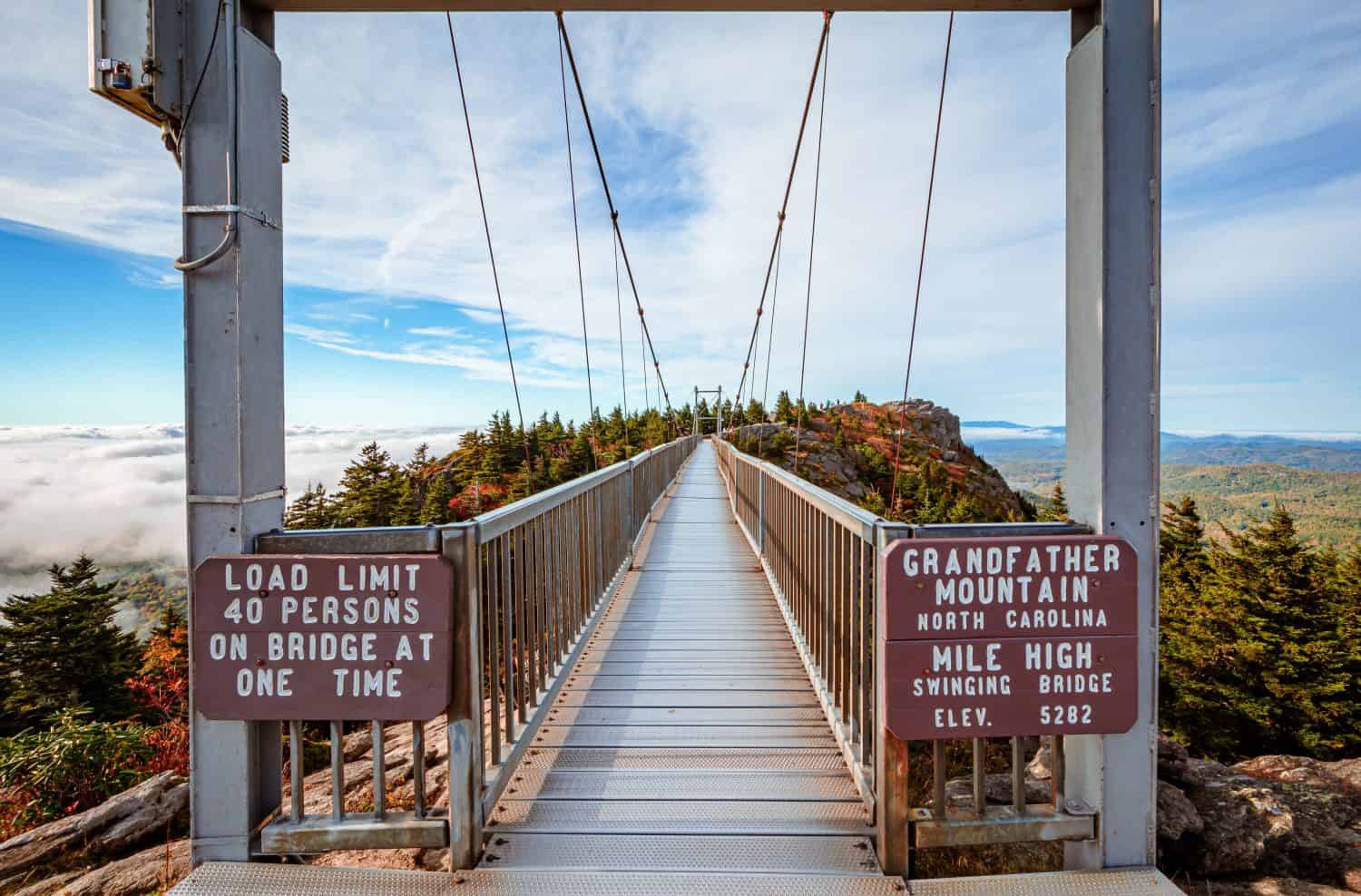
Suspended 5,946 feet in the air, Grandfather Mountain’s world-famous swinging bridge is not for the faint of heart.
©Chansak Joe/Shutterstock.com
Estimated to be 300 million years old — with certain rock formations dating back 1.2 billion years — Grandfather Mountain is widely revered for its swinging bridge and high wildlife population. This iconic area in the Blue Ridge Mountains also offers some of the most stunning panoramic views of the surrounding landscape. Moreover, Grandfather Mountain is a part of the United Nations’ Southern Appalachian Biosphere Reserve, which functions to promote communication and action for the conservation of native plants and animals. Additionally, it helps restore and protect the traditional way of life for local Native American tribes in the surrounding area.
Visitors of Grandfather Mountain can brave the Mile High Swinging Bridge, which was built in 1952. It still holds the number one spot for being the highest suspension footbridge in America. Alternatively, they can stop by the Wilson Center for Discovery for guaranteed sightings of cougars, black bears, bald eagles, river otters, and elk. To show your support, you can even adopt an animal through their Grandfather Mountain Stewardship Foundation, which helps improve the lives of all the rescued animals at their center.
11. Pisgah National Forest
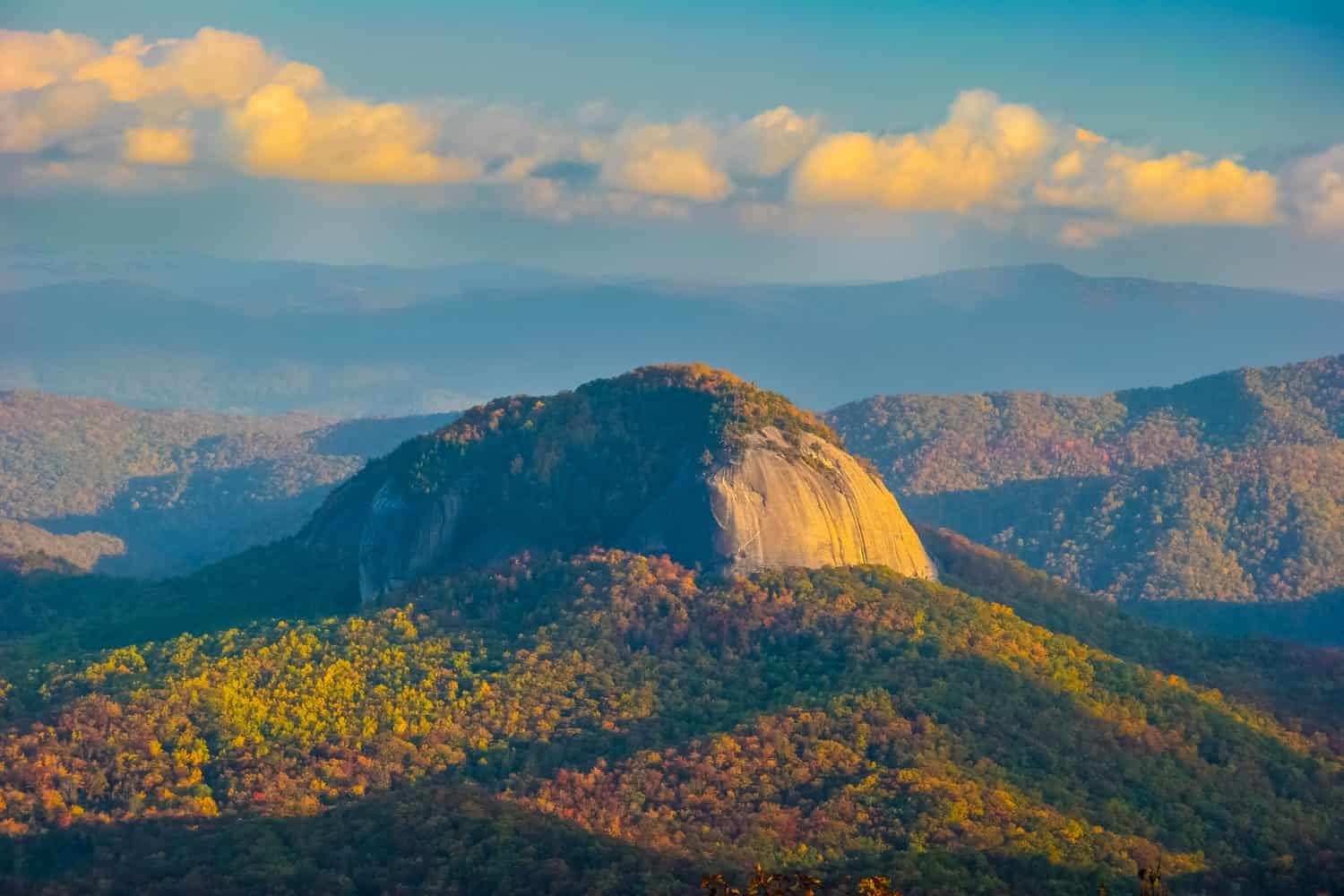
Looking Glass Rock is one of the most extraordinary natural attractions in North Carolina — especially during the fall.
©Arlene Waller/Shutterstock.com
Encompassing over 500,000 acres, Pisgah National Forest is a haven for outdoor enthusiasts and adventurers. Situated in the western part of the state, it receives a whopping 10 million visitors each year. This fan-favorite park is the site of Shining Rock and Linville Gorge — the first two designated wilderness areas in the Eastern United States. It features old-growth forests, countless waterfalls, hiking trails, extensive wildlife spotting opportunities, and the iconic Looking Glass Rock. It has a 3,969-foot elevation with cliffs rising over 500 feet in the air. Its name comes from the way its Whiteside granite surface reflects sunlight and frozen rainwater, giving it an uncanny similarity to a mirror. Looking Glass Falls is also one of North Carolina’s most popular waterfalls, thanks to its easy roadside access and scenic beauty. The fall season is especially popular for its vibrant foliage and crisp, cool weather.
12. DuPont State Recreational Forest

The Little River-Triple Falls, High Falls, Bridal Veil Falls, and Grassy Creek Falls are Dupont’s four major waterfalls, each attracting hundreds of visitors annually.
©Margaret.Wiktor/Shutterstock.com
Known for its famous appearance in media classics like The Last of the Mohicans and The Hunger Games, Dupont State Recreational Forest is one of the most overlooked natural wonders in North Carolina. Located near Asheville, this forest is notable for its stunning waterfalls. Visitors can hike, bike, fish, and picnic in the picturesque surroundings, or opt for a simpler vacation by taking a drive through any one of its many scenic routes. Each season offers its own charm, but spring and fall are popular due to the flourishing flora and fauna, as well as the park’s vibrant autumnal leaves.
All in All…

“Take nothing but pictures, and leave nothing but footprints” is a famous motto of the Leave No Trace sustainability movement.
©ThreeEyedRavenProductions/Shutterstock.com
North Carolina has a lot to offer its residents, as well as the thousands of out-of-state visitors that flock to the state each year. With a wide variety of things to do, scenic landscapes to see, and wildlife to encounter, it is clear there is no shortage of extraordinary natural attractions in North Carolina! However, to ensure these natural wonders are preserved for years to come, everyone must remember to respect the land and avoid generating unnecessary waste. Adhere to the Leave No Trace principles. The seven main guidelines are as follows: Plan ahead and prepare. Travel and camp on durable surfaces. Dispose of waste properly (uphold pack in, pack out standards). Leave what you find. And lastly, minimize campfire impacts and always be careful with fire.
Beyond these safety rules, remember to check the opening hours of all parks and campgrounds you plan to visit, as well as its accessibility if necessary. Additionally, ensure any necessary permits or fees associated with gaining entrance to these natural wonders are in your possession and accounted for prior to leaving for your trip. Above all else, enjoy exploring these extraordinary natural attractions in North Carolina!
Summary of the Top 12 Extraordinary Natural Attractions in North Carolina
| Number | Location |
|---|---|
| 1. | Great Smoky Mountains National Park |
| 2. | Blue Ridge Parkway |
| 3. | Outer Banks |
| 4. | Shackleford Banks |
| 5. | Jockey’s Ridge State Park |
| 6. | Chimney Rock State Park |
| 7. | Mount Mitchell State Park |
| 8. | Hanging Rock State Park |
| 9. | Linville Gorge and Linville Falls |
| 10. | Grandfather Mountain |
| 11. | Pisgah National Forest |
| 12. | DuPont State Recreational Forest |
Thank you for reading! Have some feedback for us? Contact the AZ Animals editorial team.








